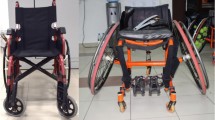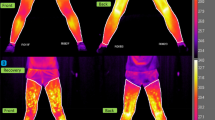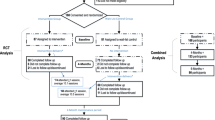Abstract
Study design: Comparison of five different exercise testing protocols with different speeds on a treadmill with seven wheelchair athletes.
Objective: To determine which speed and duration in an exercise protocol is best to test wheelchair athletes performing sprint races on a track.
Setting: Swiss Paraplegic Centre, Nottwil, Switzerland.
Methods: Three elite and four junior wheelchair athletes (18.7±6.8 years, 52.1±9.7 kg and 165.3±19.3 cm) performed five different exercise testing protocols at different speeds on a treadmill until exhaustion. Maximal effort treadmill (0.7% incline) testing protocols were performed using three timeframes. The first was focussing on short duration tests (S1 and S2) where incremental increases in velocity (0.42 and 0.1 m.s−1) were required from a stationary start. The second were medium duration tests (M1 and M2) where the athlete started at their 200 m and 800 m personal best time (mean velocities) and then had the velocity increased 1 km.h−1 by every 10 and 60 s respectively. The long duration test (L) started at 14 km.h−1 and velocity was increased by 2 km.h−1 every 120 s. Maximal heart rate, maximal concentration of lactate, maximal speed, and maximal duration of the test were measured.
Results: The highest concentration of lactate and the highest heart rates were measured in the longest tests.
Conclusion: During maximal effort testing wheelchair athletes are able to produce higher lactate concentrations when tested for longer duration. Post test lactate assessments provide little information in short duration testing protocols. Sequential lactate assessments post-test may provide additional information on the rate of recovery for middle distance wheelchair athletes and warrants further investigation.
Similar content being viewed by others
Log in or create a free account to read this content
Gain free access to this article, as well as selected content from this journal and more on nature.com
or
References
Bassett DR & Howley ET . Limiting factors for maximum oxygen uptake and determinants of endurance performance. Med Sci Sports Exerc 2000; 33: 70–84.
Bar-Or O . The Wingate anaerobic test: an update on methodology, reliability and validity. Sports Med 1987; 4: 381–397.
Hutzler Y . Anaerobic fitness testing of wheelchair users. Sports Med 1998; 25: 101–113.
Lees A . Performance characteristics of two wheelchair sprint tests. In: van der Woude LHV, Meijs PJM, de Boer YA (ed). Ergonomics of Manual Wheelchair Propulsion, State of the Art, Amsterdam: IOS Press, 1993; pp 85–91.
MacRae HSH, Dennis SC, Bosch AN & Noakes TD . Effects of training on lactate production and removal during progressive exercise in humans. J Appl Physiol 1992; 72: 1649–1656.
McGilvery RW . The use of fuels for muscular work. In: Metabolic adaptation to prolonged physical exercise. Proceedings of the Second International Symposium on Biochemistry of Exercise Magglingen 1973, Howald H, Portmans JR (ed). Basel: Birkhäuser Verlag, 1975; pp 12–30.
Kessler KM et al. Cardiovascular findings in quadriplegic and paraplegic patients and in normal subjects. Am J Cardiol 1986; 58: 525–530.
Taoutaou Z et al. Lactate kinetics during passive and partially active recovery in endurance and sprint athletes. Eur J Appl Physiol 1996; 73: 465–470.
Koziris LP & Montgomery DL . Blood lactate concentration following intermittent and continuous cycling tests of anaerobic capacity. Eur J Appl Physiol 1991; 63: 273–277.
Gupta S, Goswami A, Sadhukhan AK & Mathur DN . Comparative study of lactate removal in short term massage of extremities, active recovery and a passive recovery period after supramaximal exercise sessions. Int J Sports Med 1996; 17: 106–110.
Baker SJ & King N . Lactic acid recovery profiles following exhaustive arm exercise on a canoeing ergometer. Br J Sports Med 1991; 25: 165–167.
Boisseau N & Delamarche P . Metabolic and hormonal responses to exercise in children and adolescents. Sports Med 2000; 30: 405–422.
Author information
Authors and Affiliations
Rights and permissions
About this article
Cite this article
Knechtle, B., Hardegger, K., Müller, G. et al. Evaluation of sprint exercise testing protocols in wheelchair athletes. Spinal Cord 41, 182–186 (2003). https://doi.org/10.1038/sj.sc.3101416
Published:
Issue date:
DOI: https://doi.org/10.1038/sj.sc.3101416



